
As I am wont to do, I passed the final night of my first year at Oxford in something of a Champagne stupor. Having finished my exams in the afternoon I spent the remaining time until the dawn broke standing in a dinner jacket in the gardens at Trinity College watching my gait become steadily less reliable. The Trinity Ball was, by all accounts, the One To Be At in that summer term, but I might have forfeited the pleasure had I known that just metres away Wadham College was hosting a more modest party which featured a variety of fairground attractions. Watching twirling Ferris Wheels and a variety of Huss spinning rides jut invitingly above the ancient walls, I found myself drawn into a familiar conflict between the aesthetic and the carnal, and concluded that I had probably made the wrong decision. Oh well, you can't always get what you want.
The following morning, after a failed attempt at sleep, I did what any self-respecting Oxford undergraduate would have done once freed from the clutches of academia: I got on the first plane out of England. I had always wanted to see the battlefields of the American Civil War (and the South more generally), and a class on the subject with a flamboyant friend who shared my love for Gone With The Wind had whetted my appetite for venturing below the Mason-Dixon line. Moreover, as with any road trip through America's population centers, the potential for stop-offs at a host of coveted amusement parks were rife. With the untouchable lights of the carnival still dancing in my mind, I quickly packed a bag, took a train to the airport and, stumbling into a window seat and failing spectacularly to refuse the complimentary champagne, headed west.
Battlefields are strange places, especially when they are lovingly archived and preserved, and against their quiet solemnity it can be difficult to imagine what had once occurred; the maniacal activity, the adrenalin, the fear, the sheer and hellish chaos of war, these all feel a million miles away when filtered and curated. Subjugated now by tram routes, white fences and bronze plaques, our theatres of war can appear a touch pristine; if not quite whitewashed then certainly polished and refined. They are less preserved in aspic then ring-fenced and landscaped. The land is there, but in many cases the sense of place has vanished.
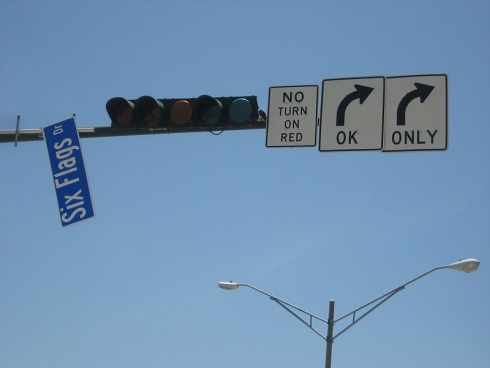
Image: Infrogmation, Wikimedia Commons (license)
I started my tour in Washington D.C. and, with the exception of a detour up to Gettysburg at the outset, I drove in a perfect backwards ‘L’ shape through Virginia, the Carolinas, Georgia, Mississippi and Alabama, finally heading across the endless Louisiana swampland and into the heady sweat of New Orleans. I had stopped periodically along the way to take in various of the quieted and preserved creases in America’s historical quilt, and now looked forward to a few days in one place, and possibly - having driven bitterly past Six Flags Over Georgia in pursuit of a deadline - a trip to an amusement park.
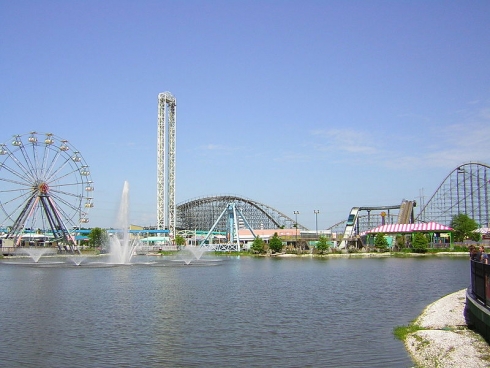
Image: Chris Hagerman, Wikimedia Commons (license)
Within hours of my arrival I was sitting nervously at 35,000 feet, literally taking flight from the city. Rumours abounded of a serious storm heading for The Big Easy and, having watched from afar as my own country’s capital city was attacked on July 7th, I was in no mood to take risks. My decision was a fortunate one: three days later I sat in Baltimore, Maryland in paralysed horror as the pictures of Katrina came in. The city from which I had fled no more than 48 hours before had been destroyed.
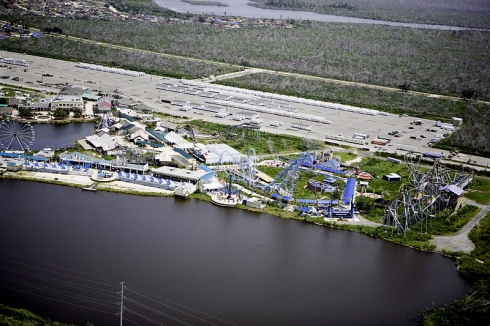
Image: Bob McMillan/FEMA
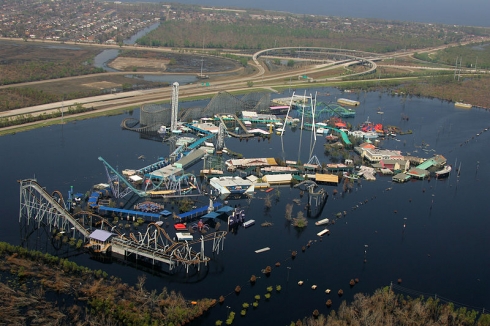
Image: Ed Edahl/FEMA
Everyone has their own epicenter. For the baker it was his bakery, for the judge his courtroom. Each family that lost their home no doubt has a zipcode and house number to mind. It was there that the hurricane hit and the waters lodged, New Orleans was just the vicinity, a backdrop, an abstraction. I did not know New Orleans at all. Beyond the human tragedy I had no connection to the city and did not stay long enough to make any. I had no focal point at all, save for the airport, but soon after the event some photographs surfaced and gave me my bearings. A few miles from the city there had been an amusement park, Six Flags New Orleans. It had a standard Bolliger & Mabillard Batman: The Ride, a Custom Coasters International wood-steel hybrid double-out-and-back named MegaZeph, a Vekoma Corkscrew named The Jester, and the commonplace Vekoma Boomerang, as well as a bunch of flat and water rides. It is no longer. On August 29th, 2005 it was hit so hard by the forces of nature that it became a write-off and now stands abandoned to its fate.
There are few sights so creepy as an abandoned amusement park, and few images which challenge so viscerally our conceptions of normality. Amusement parks are happy places. They are clean places. They are full, jostling, noisy, bright places. Places where children run around, where baby strollers sport balloons and where adults forget their quotidien responsibilities and buy unashamedly into conceits that they had shed decades back. Not this one. This, in stark opposition to the battlefields I saw, is chaos ripped out of order. It is quite the most haunting thing I have seen for a long time. I am not alone in holding a morbid fascination with abandoned amusement parks, but the question of why they have such an effect had not until recently occurred to me. Why should it be so odd to see a ruined amusement park - why more so than, say, a conference center?
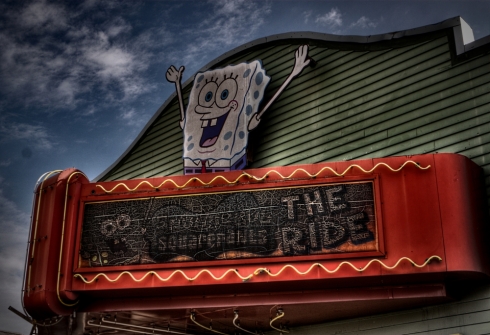
Image: Lostlosangeles
The ruins of Six Flags New Orleans look more creepy than would most because the theming was redolent of the macabre long before the winds swept in. Having been Jazzland before its acquisition by Six Flags, the park had incorporated unique voodoo motifs to the decor, and successfully created a Mardi Gras carnival atmosphere that that was tilted brilliantly towards the ersatz. Now the ersatz is the despoiled, but its totems have not disappeared. Lying anarchically around the site are mangled mannequins, solitary skeletons and broken burlesque bodies which have been given a new mystery since the disaster. Which surrealistic film director would not pay through the nose for the chance of filming these irregular ruins, panning across the rubble to take in cameo appearances by the fractured faces of clowns and poppets? The park looks like the set of a Terry Gilliam film, or one of the darker fantasies of Tim Burton. Far from being a shining city turned to rubble, it is whimsy fallen. In short, it was already half way there.
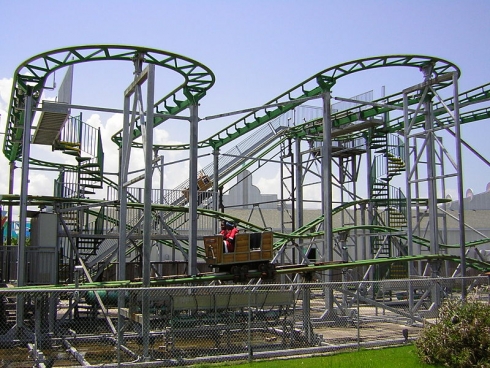
Image: Chris Hagerman, Wikimedia Commons (license)
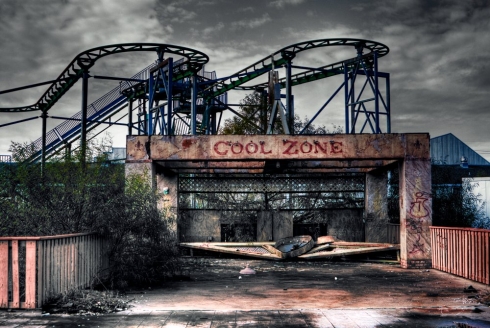
Image: Lostlosangeles
There is an uncomfortable tension in that the park has been defeated by what it sought to emulate. People primarily ride roller-coasters and clamber onto water rides in order to simulate experiences which would, if real, probably kill them. We name our rides the ‘Hurricane’ or ‘Avalanche’ or ‘Twister,’ and we promise extremes: to speed, to drop, to twist, to flood, to dangle. But we do so within the buttoned-up confines of precise Swiss engineering, rigorous safety standards and a souvenir culture. ‘I survived Supreme Scream’ boasts a t-shirt I picked up in California as a child. Of course I did, for there would be few repeat customers had I not. The thrill is to make oneself scared whilst at no point genuinely worrying that one's family will need to take advantage of the life insurance policy. We know this of course, but to see these facsimile machines laid low by the very forces they packaged in cotton wool is still humbling, and to have the screams they generated silenced by the truly terrifying is disquieting. Somewhere, even if at the back of the mind, it makes photographs of such playgrounds a little bit sad, and reminds us how weak we are. This contrast is at the essence of the thing. The park is now more creepy than it ever could have been deliberately made. Water and weeds have reclaimed the land, and improved upon it without any curation whatsoever.
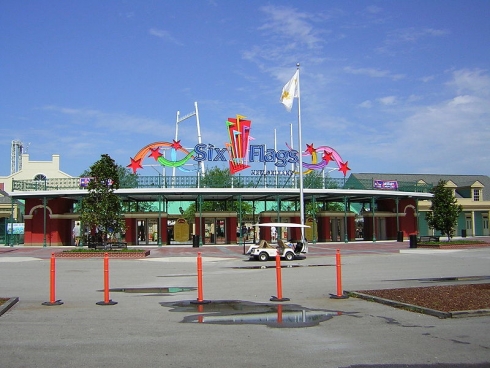
Image: Chris Hagerman, Wikimedia Commons (license)
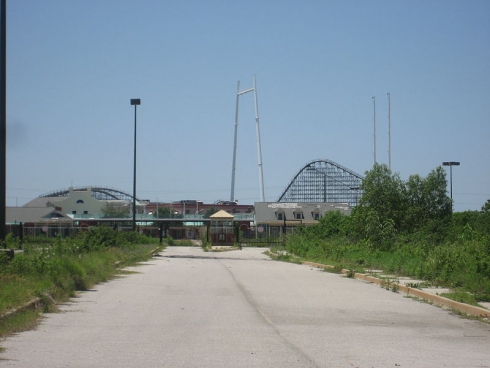
Image: Infrogmation, Wikimedia Commons (license)
It is especially desperate to witness our happy places thrown out with the bathwater, and in New Orleans the escapists’ foxhole did not evade the onslaught. To see Six Flags New Orleans leveled as indiscriminately as the rest of the city is a perturbing reminder of how holistic and comprehensive the destruction was. There is no good reason whatsoever that an amusement park should have been spared nature's whim, and there were many far more important and utilitarian places than an overblown fairground, but from whence were the afflicted now going to get their release?
Amusement parks provide days out and take our minds off of the mundane and the difficult. One could be forgiven for thinking that the residents of New Orleans had it especially tough; not only did they lose their utilities, but their distractions were washed away, too. It is not just the faint echoes of merriment that makes it sad to see, but the loss of laughter that never was. For five long years the ruins have sat untouched, the gates welcoming nobody but occasional vandals and brave photographers. All in all, it looks such a waste.
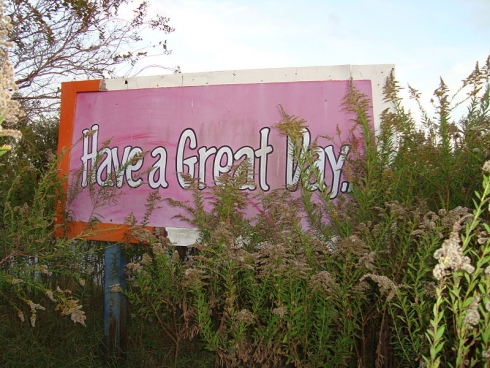
In all likelihood, what is left of Six Flags New Orleans will be demolished. Whether the cleaned slate will be replaced with another amusement park remains to be seen, but for the moment this lachrymose part of the Ninth Ward stands as a temporary exhibition to the hurricane, a tragic scar which has not yet healed. Back in 2005 as I looked longingly across the Oxford quadrangle towards the whirling fairground in the college next door, I could scarcely have imagined what real hunger would feel like. Less than a month later this irregular museum would open and set the record straight. It is the most genuine of all the battlefields I saw on the trip.
Charlie Cooke is a writer, traveller and voiceover artist. He is the author of the Charlie & The Rollercoaster blog, and splits his time between England, France and the United States.
Thanks to Loslosangeles for the use of his stunning recent pictures in the article - more can be found on his Flickr page.

Comments
Excellent piece, Charlie. Really enjoy your writing.
It's a damn shame about Jazzland. I haven't been to New Orleans since 1976, and as a 10-year old I probably didn't get to enjoy as much as I would now. ;-) Jazzland was definitely on my radar but sadly I never got there.